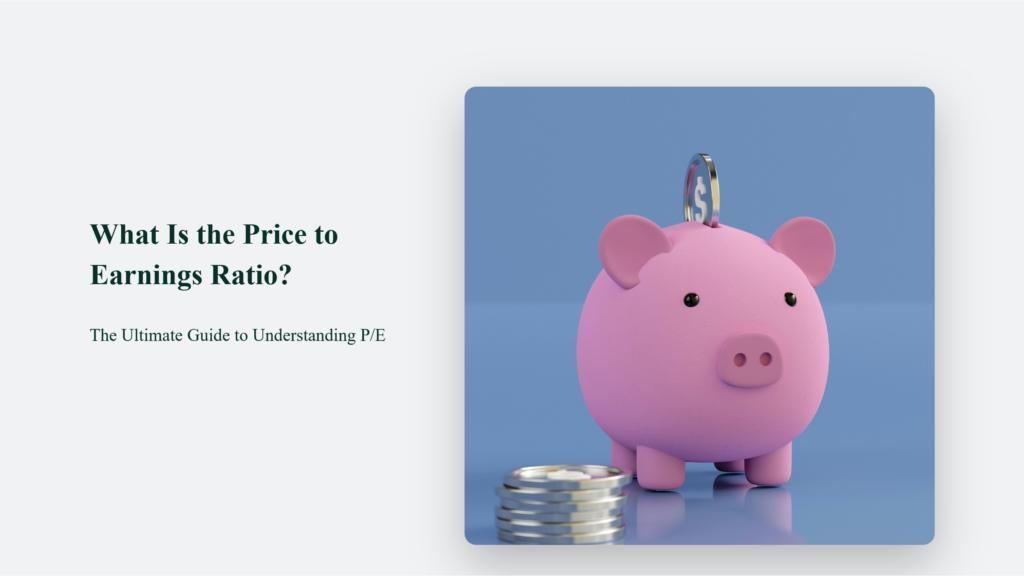You’ve probably heard investors throw around the term “P/E ratio” like it’s going out of style. But what exactly is the price-to-earnings ratio, and why should you care?
Well, stick with me, because by the end of this article, you’ll understand the Price to Earnings and use it to make smarter investment decisions. And trust me, that’s a skill that’ll serve you well whether you’re running a small business or playing the stock market.
But here’s where it gets really interesting: the price-to-earnings ratio isn’t just some dry financial metric. It’s a window into a company’s soul, a crystal ball that can help you predict future performance, and a compass that can guide your investment strategy. Intrigued? You should be.

What Is the Price to Earnings Ratio? The Nuts and Bolts
At its core, the price-to-earnings ratio (P/E ratio) is a valuation metric that compares a company’s stock price to its earnings per share (EPS). It’s like a financial speedometer, giving you a quick read on how the market values a company relative to its profitability.
The formula is deceptively simple:
P/E Ratio = Stock Price / Earnings Per Share
But don’t let that simplicity fool you. This little ratio packs a punch, and understanding its nuances can give you a serious edge in the market.
The Historical Context of Price-to-Earnings Ratio
Before we dive deeper, let’s take a quick trip down memory lane. The concept of the P/E ratio has been around since the early 20th century. Still, it really gained traction in the 1930s when Benjamin Graham and David Dodd introduced it in their seminal work, “Security Analysis.”
- 1930s: P/E ratio was introduced as a valuation tool
- 1950s-1960s: Gained popularity among investors
- 1980s-1990s: Became a staple in financial analysis
- 2000s-Present: Evolved with the rise of tech companies and new valuation methods
Understanding this history gives us context for how the P/E ratio has shaped investment strategies. But here’s the kicker: this metric is still one of the most widely used in finance today despite being nearly a century old. That’s staying power, folks.
Types of Price-to-Earnings Ratios: More Than Meets the Eye
You might think a ratio is just a ratio, but when it comes to P/E, there’s more than one flavour to choose from. Let’s break it down:
Trailing P/E
- Based on past earnings
- More commonly used
- Calculated using the last 12 months of actual earnings
Forward P/E
- Based on projected future earnings
- More speculative but potentially more relevant
- Calculated using analysts’ earnings estimates for the next 12 months
Shiller P/E (CAPE)
- Cyclically Adjusted Price-to-Earnings ratio
- Uses average earnings over the past 10 years
- Aims to smooth out short-term fluctuations
Each type has its pros and cons, and knowing when to use it can make you look like a financial wizard. But remember, no single metric tells the whole story. It’s all about context, baby.
How to Calculate Price-to-Earnings Ratio: The Devil’s in the Details
Alright, let’s roll up our sleeves and get into the nitty-gritty of calculating the P/E ratio. It might seem straightforward, but there are some nuances you need to know.
- Find the current stock price
- Determine the earnings per share (EPS)
- Divide the stock price by EPS
Sounds simple, right? But here’s where it gets tricky. The EPS you use can significantly impact the ratio. Are you using trailing EPS or projected EPS? Are you factoring in one-time events or extraordinary items? These decisions can make a big difference in your final P/E number.
Let’s look at an example:
Company XYZ’s stock is trading at $50 per share. Its earnings per share for the last 12 months were $2.50.
P/E Ratio = $50 / $2.50 = 20
This means that investors are willing to pay $20 for every dollar of the company’s earnings. But is that good or bad? Well, that depends on many factors, which we’ll discuss next.
Interpreting Price-to-Earnings Ratio: The Art and Science
Now that we know what the P/E ratio is and how to calculate it, let’s talk about what it actually means. This is where things get interesting, and your interpretation skills come into play.
High P/E Ratio
A high P/E ratio generally indicates that investors expect higher earnings growth in the future. It could mean:
- The company is overvalued
- Investors have high expectations for future growth
- The stock is considered a “growth stock.”
Low P/E Ratio
A low P/E ratio might suggest:
- The company is undervalued
- Investors have low expectations for future growth
- The stock is considered a “value stock.”
But here’s the catch: what’s considered “high” or “low” can vary wildly depending on the industry, market conditions, and a host of other factors. A P/E of 15 might be high in one industry and low in another. It’s all relative, folks.
Price-to-Earnings Ratio in Different Industries: Not All P/Es Are Created Equal
Remember when I said context matters? Well, this is where that really comes into play. Different industries have different average P/E ratios, and for good reason.
- Tech Companies: Often have higher P/Es due to expected future growth
- Utilities: Generally have lower P/Es due to stable but slow growth
- Cyclical Industries: P/Es can fluctuate widely based on economic cycles
For example, as of 2023, the average P/E ratio for the S&P 500 is around 20-25. But within that:
- Technology sector: Average P/E around 30-35
- Utility sector: Average P/E around 15-20
- Financial sector: Average P/E around 12-15
So, when you’re looking at a company’s P/E ratio, always compare it to its industry peers. It’s like comparing apples to apples instead of apples to, well, tech stocks.
Limitations of Price-to-Earnings Ratio: The Elephant in the Room
Now, I wouldn’t be doing my job if I didn’t point out the limitations of the P/E ratio. Sure, it’s a useful tool, but it’s not the be-all and end-all of stock valuation.
- Doesn’t account for debt levels
- Can be manipulated through accounting practices
- Doesn’t work well for companies with negative earnings
- Doesn’t consider the company’s growth rate
This is why savvy investors use P/E ratio in conjunction with other metrics like PEG ratio, price-to-book ratio, and debt-to-equity ratio. It’s all about getting a 360-degree view of a company’s financial health.
Price-to-Earnings Ratio in Value Investing: Warren Buffett’s Secret Sauce
You didn’t think we’d get through an article on P/E ratio without mentioning Warren Buffett, did you? The Oracle of Omaha has made a career out of using P/E ratios (among other metrics) to identify undervalued companies.
Buffett’s strategy often involves looking for companies with:
- Low P/E ratios relative to their industry
- Consistent earnings growth
- Strong competitive advantages
But here’s the twist: Buffett doesn’t just look at the current P/E. He often considers the average P/E over several years to smooth out short-term fluctuations. It’s all about the long game, people.
The Future of Price-to-Earnings Ratio: Adapting to a Changing Market
As we wrap up, let’s take a peek into the crystal ball. How will the P/E ratio evolve in the face of changing market dynamics?
- Impact of intangible assets on earnings
- The rise of alternative valuation methods for tech startups
- The growing importance of non-financial metrics (ESG factors, anyone?)
The P/E ratio has stood the test of time, but like everything in finance, it’s evolving. Staying ahead of these trends could give you a serious edge in your investment strategy.
Conclusion: Mastering the Price-to-Earnings Ratio
So there you have it, folks. We’ve taken a deep dive into the world of price-to-earnings ratios, from its historical roots to its modern-day applications and limitations. By now, you should have a solid grasp on what P/E ratio is, how to calculate it, and most importantly, how to use it in your investment decisions.
Remember, the P/E ratio is a powerful tool, but it’s just one piece of the puzzle. Use it wisely, always consider the context, and never stop learning. Because in the world of finance, knowledge isn’t just power—it’s profit.
Now, go forth and conquer the markets. And if you need help translating all this financial wizardry into killer marketing strategies, well, you know where to find us at CJ&CO. After all, understanding the numbers is just the first step in telling a compelling business story.
Frequently Asked Questions:
What is a good P/E ratio?
There’s no one-size-fits-all answer here. A “good” P/E ratio depends on the industry, market conditions, and company growth prospects. Generally, a P/E ratio between 15-25 is considered average for the S&P 500. However, high-growth tech companies might have P/Es over 30, while stable, mature companies might have P/Es under 15. Always compare a company’s P/E to its industry average and historical levels.
Can the P/E ratio be negative?
Technically, yes. A negative P/E ratio occurs when a company has negative earnings (i.e., it’s losing money). However, negative P/E ratios aren’t typically reported because they’re not meaningful for valuation purposes. Instead, you’ll often see these listed as “N/A” or simply not reported.
How often should I check a company’s P/E ratio?
While it’s good to keep an eye on P/E ratios, obsessing over daily changes isn’t productive. Quarterly updates, when companies report earnings, are usually sufficient. Remember, P/E ratios can fluctuate based on market sentiment, so it’s more useful to look at trends over time rather than snapshot values.




